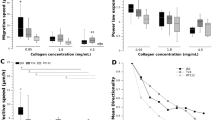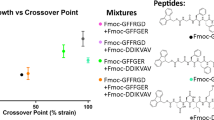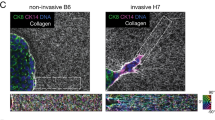Abstract
The mechanics and architectures of the extracellular matrix (ECM) critically influence 3D cell migration processes, such as cancer cell invasion and metastasis. Understanding the roles of mechanical and structural factors in the ECM could provide an essential basis for cancer treatment. However, it is generally difficult to independently characterize these roles due to the coupled changes in these factors in conventional ECM model systems. In this study, to solve this problem, we developed elasticity/porosity-tunable electrospun fibrous gel matrices composed of photocrosslinked gelatinous microfibers (nanometer-scale-crosslinked chemical gels) with well-regulated bonding (tens-of-micron-scale fiber-bonded gels). This system enables independent modulation of microscopic fiber elasticity and matrix porosity, i.e., the mechanical and structural conditions of the ECM. The elasticity of fibers was tuned with photocrosslinking conditions. The porosity was regulated by changing the degree of interfiber bonding. The influences of these factors of the fibrous gel matrix on the motility of MDA-MB-231 tumorigenic cells and MCF-10A nontumorigenic cells were quantitatively investigated. MDA-MB-231 cells showed the highest degree of MMP-independent invasion into the matrix composed of fibers with a Young’s modulus of 20 kPa and a low degree of interfiber bonding, while MCF-10A cells did not show invasive behavior under the same matrix conditions.
This is a preview of subscription content, access via your institution
Access options
Subscribe to this journal
Receive 12 print issues and online access
$259.00 per year
only $21.58 per issue
Buy this article
- Purchase on Springer Link
- Instant access to full article PDF
Prices may be subject to local taxes which are calculated during checkout









Similar content being viewed by others
References
DeVita VT, Lawrence TS, Rosenberg ED. Cancer: principles & practice of oncology: primer of the molecular biology of cancer. Philadephia: Lippincott Wiliams & Wilkins; 2012.
Hay ED. An overview of epithelio-mesenchymal transformation. Acta Anat. 1995;154:8–20.
Kalluri R, Neilson EG. Epithelial-mesenchymal transition and its implications for fibrosis. Arch Otolaryngol - Head Neck Surg. 2003;112:1776–84.
Kalluri R, Weinberg RA. The basics of epithelial-mesenchymal transition. J Clin Investig. 2009;119:1420–8.
Mierke CT, Frey B, Fellner M, Herrmann M, Fabry B. Integrin α5β1 facilitates cancer cell invasion through enhanced contractile forces. J Cell Sci. 2011;124:369–83.
Fischer T, Wilharm N, Hayn A, Mierke CT. Matrix and cellular mechanical properties are the driving factors for facilitating human cancer cell motility into 3D engineered matrices. Converg Sci Phys Oncol. 2017;3:044003.
Anseth KS, Schwartz MP, Witze ES, Nguyen EH, Ahn NG, Sharma Y, et al. A quantitative comparison of human HT-1080 fibrosarcoma cells and primary human dermal fibroblasts identifies a 3D migration mechanism with properties unique to the transformed phenotype. PLoS ONE. 2013;8:e81689
Bray D. Cell movements: from molecules to motility. New York: Garland Science; 2001.
Lange JR, Fabry B. Cell and tissue mechanics in cell migration. Exp Cell Res. 2013;319:2418–23.
De Pascalis C, Etienne-Manneville S. Single and collective cell migration: the mechanics of adhesions. Mol Biol Cell. 2017;28:1833–46.
Shan J, Chi Q, Wang H, Huang Q, Yang L, Yu G, et al. Mechanosensing of cells in 3D gel matrices based on natural and synthetic materials. Cell Biol Int.2014;38:1233–43.
Lee JY, Chaudhuri O. Regulation of breast cancer progression by extracellular matrix mechanics: insights from 3D culture models. ACS Biomater Sci Eng. 2018;4:302–13.
Soman P, Kelber JA, Lee JW, Wright TN, Vecchio KS, Klemke RL, et al. Cancer cell migration within 3D layer-by-layer microfabricated photocrosslinked PEG scaffolds with tunable stiffness. Biomaterials. 2012;33:7064–70.
Baker BM, Trappmann B, Wang WY, Sakar MS, Kim IL, Shenoy VB, et al. Cell-mediated fibre recruitment drives extracellular matrix mechanosensing in engineered fibrillar microenvironments. Nat Mater.2015;14:1262–68.
Kursad, T. Extracellular matrix for tissue engineering and biomaterials. Cham, Switzerland: Springer International Publishing AG, part of Springer Nature; 2018.
Peter, F. Collagen structure and mechanics. Berlin/Heidelberg, Germany: Springer Science+Business Media, LLC; 2008.
Kidoaki S, Matsuda T. Microelastic gradient gelatinous gels to induce cellular mechanotaxis. J Biotechnol. 2008;133:225–30.
Hertz H. Über die Berührung fester elastischer Körper. J für die reine und Angew Math. 1881;171:156–71.
Radmacher M, Fritz M, Hansma PK. Imaging soft samples with the atomic force microscope: gelatin in water and propanol. Biophys J. 1995;69:264–70.
Wu HW, Kuhn T, Moy VT. Mechanical properties of L929 cells measured by atomic force microscopy: Effects of anticytoskeletal drugs and membrane crosslinking. Scanning. 1998;20:389–97.
Nishino N, Powers JC. Peptide hydroxamic acids as inhibitors of thermolysin. Biochemistry. 1978;17:2846–50.
Kidoaki S, Kwon IK, Matsuda T. Structural features and mechanical properties of in situ-bonded meshes of segmented polyurethane electrospun from mixed solvents. J Biomed Mater Res—Part B Appl Biomater. 2006;76:219–29.
Parekh A, Weaver AM. Regulation of cancer invasiveness by the physical extracellular matrix environment. Cell Adhes Migr. 2009;3:288–92.
Parekh A, Weaver AM. Regulation of invadopodia by mechanical signaling. Exp Cell Res. 2016;343:89–95.
Kraning-Rush CM, Califano JP, Reinhart-King CA. Cellular traction stresses increase with increasing metastatic potential. PLoS ONE. 2012;7:e32572.
Haage A, Schneider IC. Cellular contractility and extracellular matrix stiffness regulate matrix metalloproteinase activity in pancreatic cancer cells. FASEB J. 2014;28:3589–99.
Rath N, Olson MF. Regulation of pancreatic cancer aggressiveness by stromal stiffening. Nat Med. 2016;22:462–3.
Johnson AR, Pavlovsky AG, Ortwine DF, Prior F, Man CF, Bornemeier DA, et al. Discovery and characterization of a novel inhibitor of matrix metalloprotease-13 that reduces cartilage damage in vivo without joint fibroplasia side effects. J Biol Chem.2007;282:27781–91.
Devy L, Huang L, Naa L, Yanamandra N, Pieters H, Frans N, et al. Selective inhibition of matrix metalloproteinase-14 blocks tumor growth, invasion, and angiogenesis. Cancer Res. 2009;69:1517–26.
Wolf K, Friedl P. Mapping proteolytic cancer cell-extracellular matrix interfaces. Clin Exp Metastasis. 2009;26:289–98.
Pathak A, Kumar S. Biophysical regulation of tumor cell invasion: Moving beyond matrix stiffness. Integr Biol. 2011;3:267–78.
Wyckoff JB, Pinner SE, Gschmeissner S, Condeelis JS, Sahai E. ROCK- and myosin-dependent matrix deformation enables protease-independent tumor-cell invasion in vivo. Curr Biol. 2006;16:1515–23.
Wolf K, te Lindert M, Krause M, Alexander S, te Riet J, Willis AL, et al. Physical limits of cell migration: Control by ECM space and nuclear deformation and tuning by proteolysis and traction force. J Cell Biol.2013;201:1069–84.
Davidson PM, Denais C, Bakshi MC, Lammerding J. Nuclear deformability constitutes a rate-limiting step during cell migration in 3-D environments. Cell Mol Bioeng. 2014;7:293–306.
Lautscham LA, Kämmerer C, Lange JR, Kolb T, Mark C, Schilling A. et al. Migration in Confined 3D Environments Is Determined by a Combination of Adhesiveness, Nuclear Volume, Contractility, and Cell Stiffness. Biophys J. 2015;109:900–13.
Nandakumar V, Kelbauskas L, Hernandez KF, Lintecum KM, Senechal P, Bussey KJ, et al. Isotropic 3D nuclear morphometry of normal, fibrocystic and malignant breast epithelial cells reveals new structural alterations. PLoS ONE. 2012;7:e29230.
Sabeh F, Shimizu-Hirota R, Weiss SJ. Protease-dependent versus-independent cancer cell invasion programs: Three-dimensional amoeboid movement revisited. J Cell Biol. 2009;185:11–9.
Friedl P, Wolf K, Lammerding J. Nuclear mechanics during cell migration. Curr Opin Cell Biol. 2011;23:55–64.
Giannone G, Sheetz MP. Substrate rigidity and force define form through tyrosine phosphatase and kinase pathways. Trends Cell Biol. 2006;16:213–23.
Mierke CT, Kollmannsberger P, Zitterbart DP, Smith J, Fabry B, Goldmann WH. Mechano-coupling and regulation of contractility by the vinculin tail domain. Biophys J. 2008;94:661–70.
Mierke CT, Zitterbart DP, Goldmann WH, Koch TM, Fabry B, Kollmannsberger P, et al. Vinculin Facilitates Cell Invasion into Three-dimensional Collagen Matrices. J Biol Chem.2010;285:13121–30.
Wang C, Tong X, Yang F. Bioengineered 3D brain tumor model to elucidate the effects of matrix stiffness on glioblastoma cell behavior using peg-based hydrogels. Mol Pharm. 2014;11:2115–25.
Han SJ, Bielawski KS, Ting LH, Rodriguez ML, Sniadecki NJ. Decoupling substrate stiffness, spread area, and micropost density: A close spatial relationship between traction forces and focal adhesions. Biophys J. 2012;103:640–8.
Friedl P, Wolf K. Plasticity of cell migration: a multiscale tuning model. J Cell Biol 2010;188:11–9.
Parekh A, Ruppender NS, Branch KM, Sewell-Loftin MK, Lin J, Boyer PD, et al. Sensing and modulation of invadopodia across a wide range of rigidities. Biophys J.2011;100:573–82.
Guo WH, Frey MT, Burnham NA, Wang YL. Substrate rigidity regulates the formation and maintenance of tissues. Biophys J. 2006;90:2213–20.
Mak M, Spill F, Kamm RD, Zaman MH. Single-cell migration in complex microenvironments: mechanics and signaling dynamics. J Biomech Eng. 2016;138:021004.
Tocco VJ, Li Y, Christopher KG, Matthews JH, Aggarwal V, Paschall L, et al. The nucleus is irreversibly shaped by motion of cell boundaries in cancer and non-cancer cells. J Cell Physiol.2018;233:1446–54.
Denais C, Lammerding J. Nuclear mechanics in cancer. Adv Exp Med Biol. 2014;773:435–70.
Lee MH, Wu PH, Staunton JR, Ros R, Longmore GD, Wirtz D. Mismatch in mechanical and adhesive properties induces pulsating cancer cell migration in epithelial monolayer. Biophys J. 2012;102:2731–41.
Guck J, Schinkinger S, Lincoln B, Wottawah F, Ebert S, Romeyke M, et al. Optical deformability as an inherent cell marker for testing malignant transformation and metastatic competence. Biophys J.2005;88:3689–98.
Suresh S. Biomechanics and biophysics of cancer cells. Acta Mater. 2007;55:3989–4014.
Corbin EA, Kong F, Lim CT, King WP, Bashir R. Biophysical properties of human breast cancer cells measured using silicon MEMS resonators and atomic force microscopy. Lab Chip. 2015;15:839–47.
Sapudom J, Rubner S, Martin S, Kurth T, Riedel S, Mierke CT, et al. The phenotype of cancer cell invasion controlled by fibril diameter and pore size of 3D collagen networks. Biomaterials. 2015;52:367–75.
Mukherjee A, Behkam B, Nain AS. Cancer cells sense fibers by coiling on them in a curvature-dependent manner. iScience. 2019;19:905–15.
Eslami Amirabadi H., SahebAli S, Frimat JP, Luttge R, den Toonder JMJ. A novel method to understand tumor cell invasion: integrating extracellular matrix mimicking layers in microfluidic chips by “selective curing”. Biomed. Microdevices. 2017;19:92.
Yeung T, Georges PC, Flanagan LA, Marg B, Ortiz M, Funaki M., et al. Effects of substrate stiffness on cell morphology, cytoskeletal structure, and adhesion. Cell Motil Cytoskeleton. 2005;60:24–34.
Funding
This work was supported by a Grant-in-Aid for Scientific Research (15K12513) from the Ministry of Education, Culture, Sports, Science and Technology (MEXT) of Japan and a grant for Core Research for Evolutionary Medical Science and Technology from the Japan Agency of Medical Research and Development (AMED-CREST, JP19gm0810002).
Author information
Authors and Affiliations
Contributions
SK developed the idea for the study; DH, YN and AO performed the research and analyzed the data; and SK and DH wrote and revised the paper. All authors gave final approval for publication.
Corresponding author
Ethics declarations
Conflict of interest
The authors declare that they have no conflict of interest.
Additional information
Publisher’s note Springer Nature remains neutral with regard to jurisdictional claims in published maps and institutional affiliations.
Supplementary information
Rights and permissions
About this article
Cite this article
Huang, D., Nakamura, Y., Ogata, A. et al. Characterization of 3D matrix conditions for cancer cell migration with elasticity/porosity-independent tunable microfiber gels. Polym J 52, 333–344 (2020). https://doi.org/10.1038/s41428-019-0283-3
Received:
Revised:
Accepted:
Published:
Issue Date:
DOI: https://doi.org/10.1038/s41428-019-0283-3



